The NT Times had a recent article discussing laser nuclear fusion. Nextbigfuture has spoken with all of the nuclear fusion companies listed in the NY Times article as they all attended the 2023 International Conference on Inertial Fusion Sciences and Applications conference.
Nextbigftuure covered detailed National Ignition Facility presentations six weeks ago at the 2023 International Conference on Inertial Fusion Sciences and Applications. The National Ignition Facility has increased power to 2.2 megajoules for tests this month which is up from 2.05 megajoules earlier in the year. They are investigating a series of new targets. IF this round of experiments goes well the power output could increase to 5-10 megajoules which is up from the best 3.88 megajoule shot. There is a clear path to increasing power to 2.6 megajoules which could achieve 10-20 megajoules of output. The current facility could be maxed out at 3.0 megajoules if substantial upgrades are funded. The 3.0 megajoule tests would be around 2030 and each step up in power takes 1-2 years.
Nextbigfuture has covered all of the laser fusion startups:
Focused Energy, a laser-based fusion startup dedicated to developing fusion as a means of generating clean alternative energy, raised an additional $11 million in Series A funding, bringing their total funding to $82 million. The round was led by Prime Movers Lab, and previous investors VCP Capital and Tony Florence joined the round as well.
Focused Energy wants to build a demonstrator in 8 to 9 years with a 100-beam compression laser producing 500 kilojoule pulses, one-quarter the energy of NIF’s. For the short ignition pulses, they plan to use lasers developed for Europe’s Extreme Light Infrastructure, a research facility. Each produces pulses of 1.5 kilojoules so Focused Energy will need 100 of them, combining their output into a single beam to set the fuel alight.
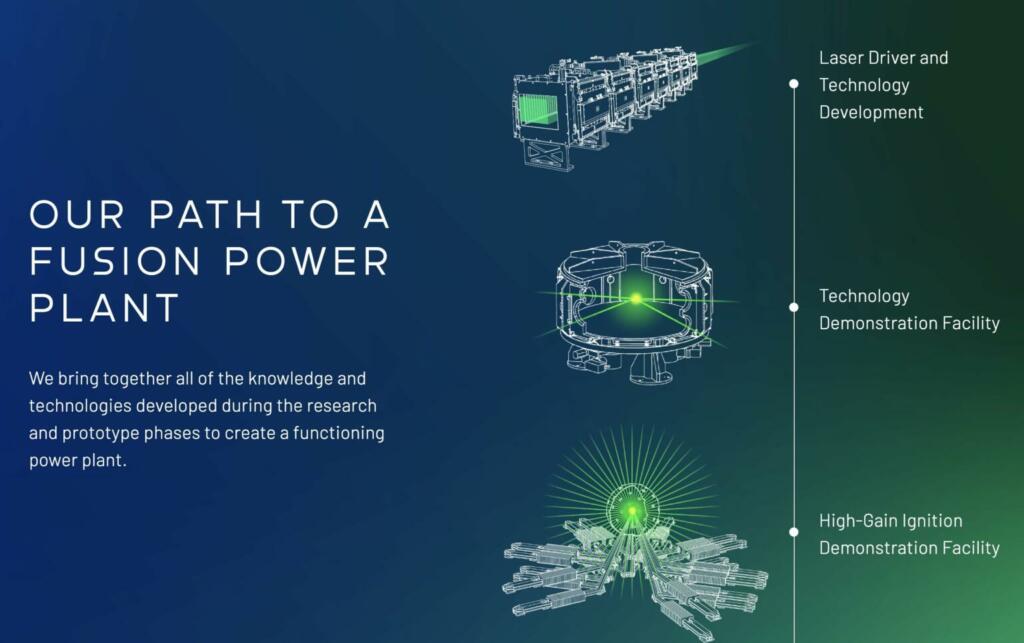
Last September for a Milestone-Based Fusion Development Program, the DOE (dept of Energy) awarded Xcimer $9 million to develop their lasers.
5. HB11 Energy
HB11 Energy is working towards proton boron (pB) fusion. This requires more energy than Deuterium–tritium (DT) fusion. However, the big advantages of pB over DT is that there is no need for tritium and no nuclear waste. Tritium does no occur in nature. There is only about 20 kilograms of tritium in the world. IF there was an attempt to commercialize the International Tokamak project with follow on projects all of the tritium would be used with any full scale demonstration reactor. All DT fusion companies have to create a Tritium breeding system or have large scale tririum factories.
It takes 140 kilos of Li-6 to obtain the 70 kilos of tritium necessary to producing one gigawatt of thermal power for one year.
Assuming an availability of 80 percent and a conversion efficiency from thermal to electrical power of 30 percent, the production of one gigawatt of electrical power (the estimated size of an average fusion reactor) will require approximately 500 kilos of Li-6 per year, which would bring the total requirement for 10,000 reactors to 5,000 tonnes annually. There are approximately 50 million tonnes of proven lithium reserves in the world¹, which means about 3 million tonnes of Li-6.
If all of the heavy water CANDU reactors had tritium capture facilities then Tritium production from CANDU reactors worldwide would be 20 kilos per year. However, only about 10% of the CANDU tritium is captured.
Techno economics model show that proton boron can get to the sub-$1 per target price that is needed. DT fusion has to not only get the tritium but they have to bring the cost of targets down about 100-1000 times.
6. Marvel Energy
Marvel wants to mix proton boron with deuterium and tritium and create solid targets.
7. First Light Fusion
First Light Fusion, a company based in Oxford, UK, has raised $105 million in funding over four rounds. First Light plans to use projectiles to create fusion.
First Light will amplify the power of the projectiles with layered material that will reflect and boost the power of the shock wave.
8. Nearstar fusion will also use projectiles to create fusion. Nearstar will combine the projectiles with magnetic fields.
NIF Detailed Plans
The National Ignition Facility (NIF) at Lawrence Livermore National Lab (LLNL) made worldwide news when they reached nuclear fusion ignition in December 2022 but they went beyond that result on July 30, 2023.
I have also spoken with several of the speakers.
The Big 3 recent results were:
1. Aug 8, 2021 1.9 megajoules (MJ) of laser power was fired at a target which resulted in the release of 1.35 megajoules (0.72 return)
2. Dec 5, 2022 2.05 megajoules was fired at a target which resulted in the release of 3.15 megajoules (1.54X gain)
3. July 30, 2023 2.05 megajoules was fired at a target which resulted in the release of 3.88 megajoules (1.9X gain)

After Aug 8, 2021 there were several shots that did not reach a megajoule of returned power. There was a lot of work improving the targets and adjusting how the lasers were fired. The power of the entire system was increased by 8% from 1.9 MJ to 2.05 MJ. The quality of the targets had to be improved. They had to prevent three different major kinds of errors.
Keeping the system working at 2.05MJ or even 1.9MJ is difficult. The system is operating beyond its designed levels of 1.8MJ. The NIF system has damage that has to be repaired after shots are made.
There is software autotuning to calculate the adjustments to the laser pulse the target (holhraum).

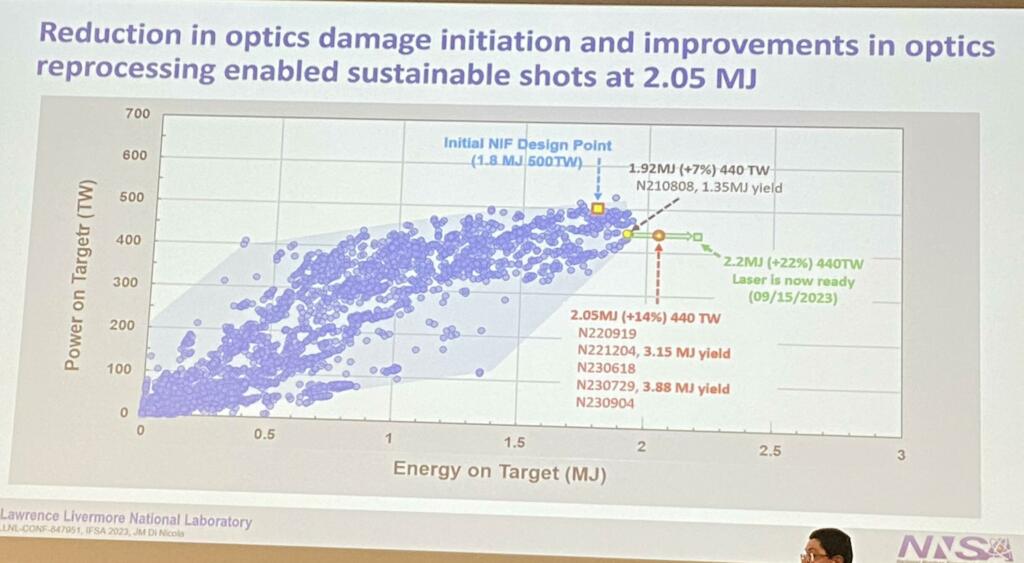
There are plans to increase the power to 3 MJ which would conservatively deliver more than a 10X gain and 30 MJ.
They have already prepared the NIF lasers and facility to operate with 2.2 MJ shots. The first 2.2 MJ shot are calculated to deliver 5-10 MJ. Modifying the target shape from a pill capsule like shape to one with a wide centerline with two stacked trapezoids (Frustraum) could deliver over 10 MJ using 2.2 MJ of laser power.

Tests have been made that indicate the current system could reach 2.6 MJ with fresh amplifier glass lens. NIF has bought and stored all of the original production of amplifier glass. The 2.6 MJ (and any midpoint between 2.2 MJ and 3MJ) has not been funded or approved. However, it would offer a lot of fusion bang for the buck to go to 2.6 MJ and then to make the modifications for 3 MJ. Timing and schedules are all highly uncertain but 2 years at 2.2MJ and then 2 years of testing at 2.6MJ makes sense to me. A
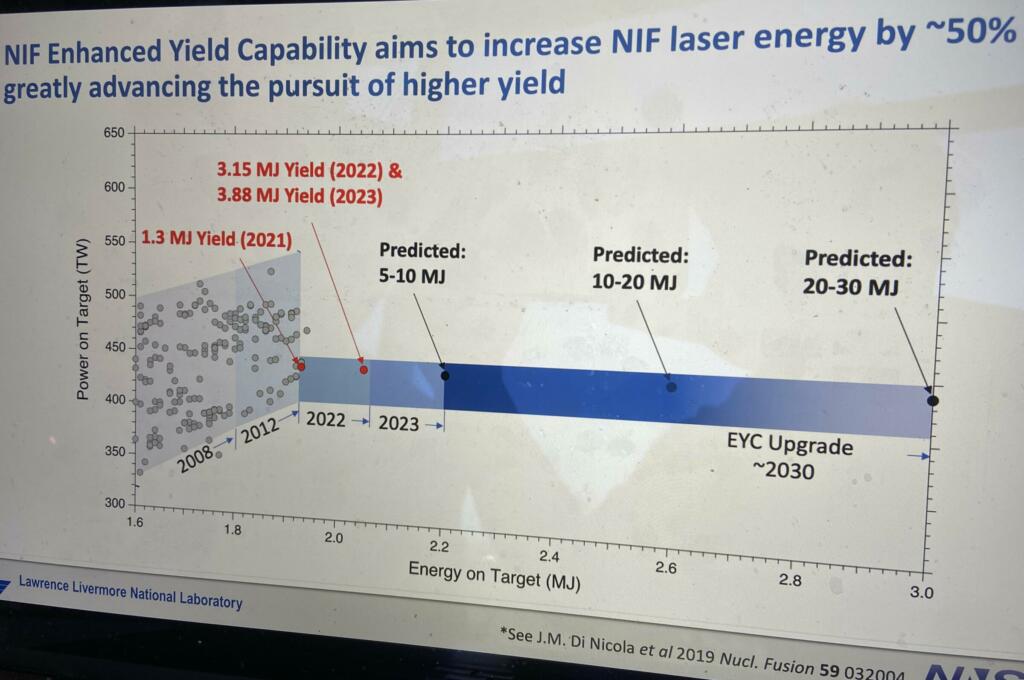


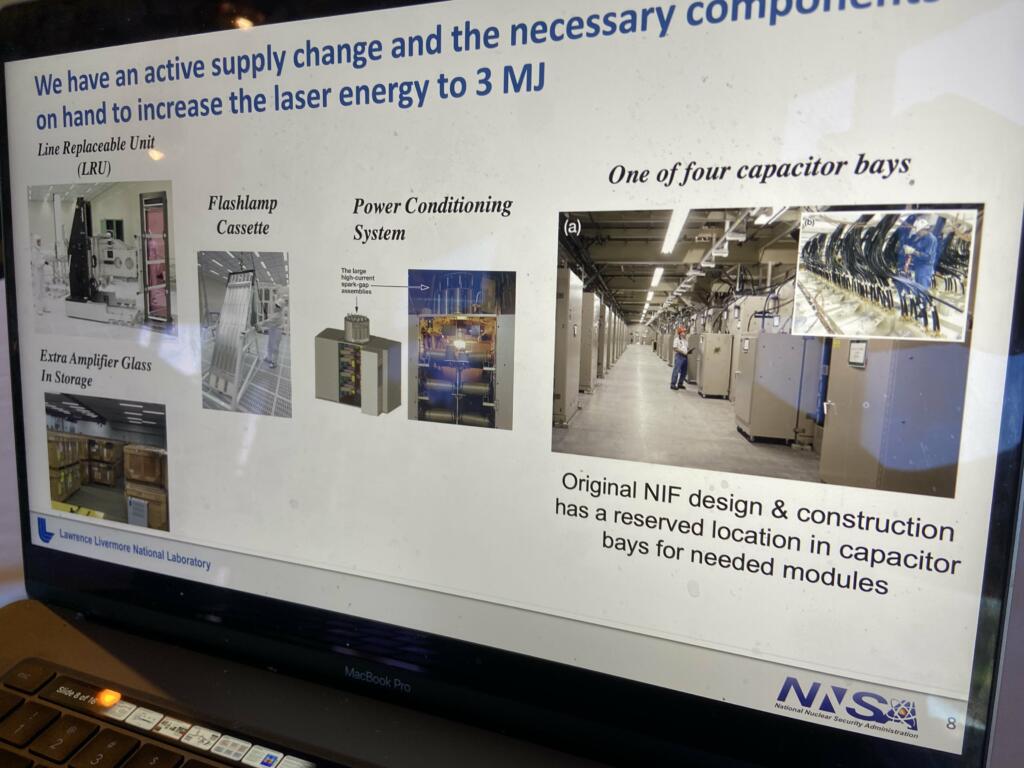

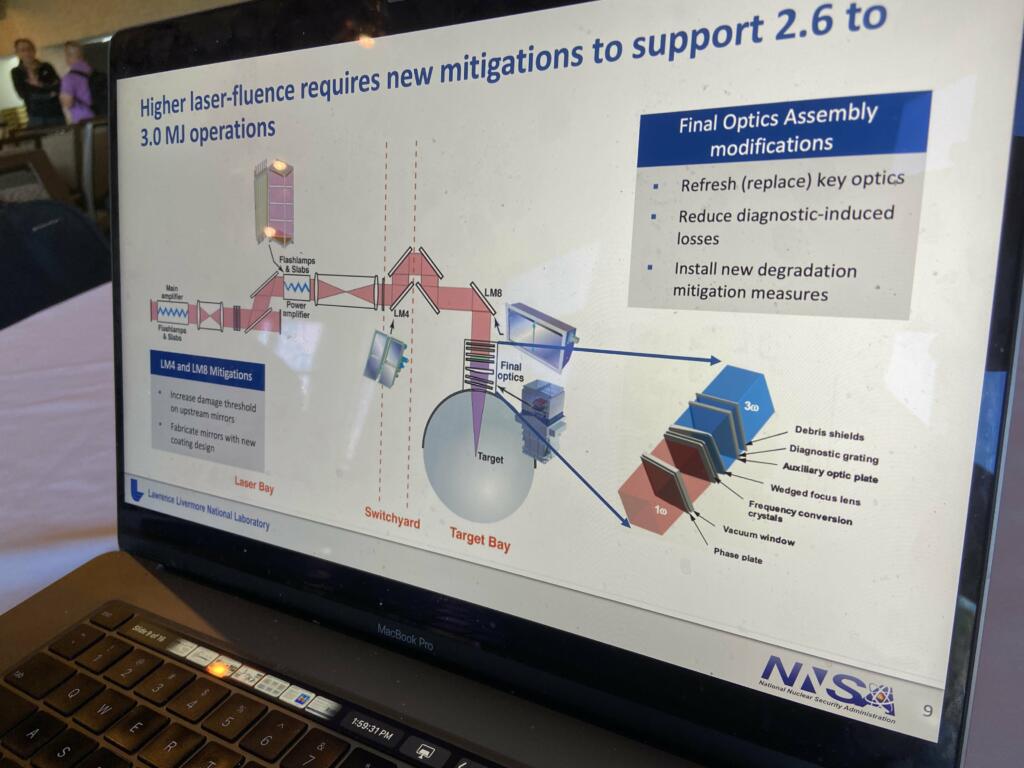
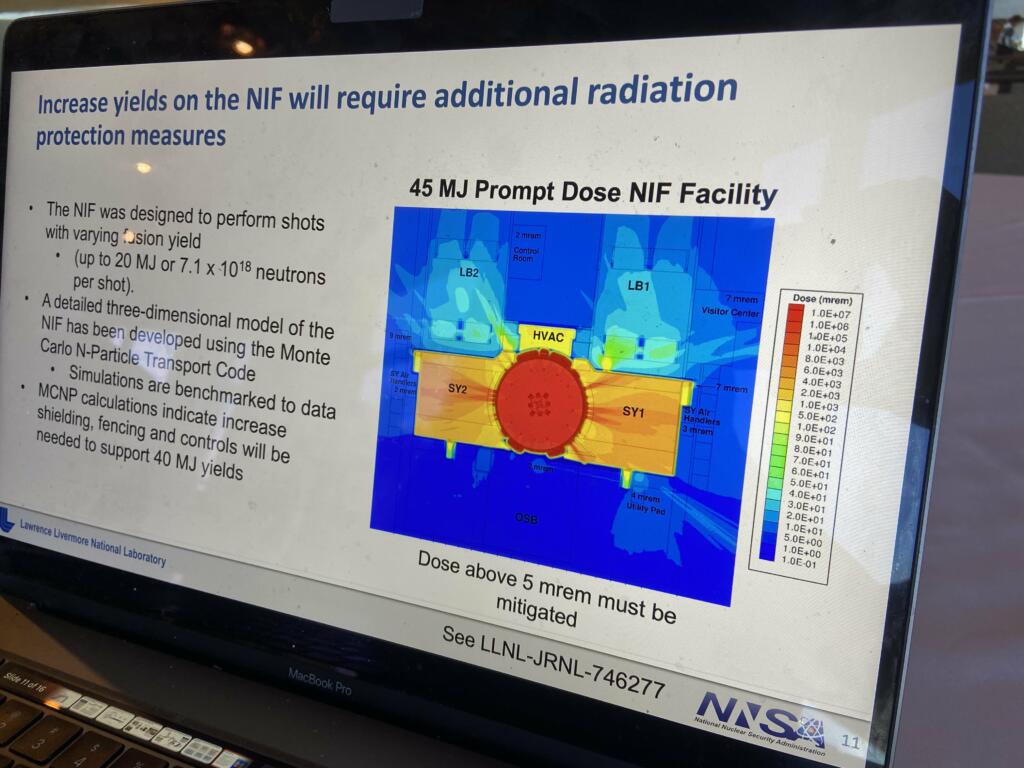
There is still selections and approvals to be made on how to perform higher power or high energy work.
The National Nuclear Security Administration (NNSA) makes the decisions about LLNL operations. Since its inception in 1952, LLNL’s defining responsibility has been national security — ensuring the safety, security and effectiveness of the nation’s nuclear stockpile. Nuclear Stockpile sustainment is still the main role.
LLNL’s mission has broadened in recent years, as dangers ranging from nuclear proliferation and terrorism to cyber-attacks and climate change increasingly threaten national security and global stability.
LLNL developing and proving that laser nuclear fusion is promising for potential commercial energy generation is greatly appreciated.
Future of NIF Laser Fusiom
I think that the campaigns to increase NIF power to 2.6 MJ and to 3 MJ makes a lot of sense.
It could also achieve 10-20MJ or more at 2.6MJ and 30+MJ with 3 MJ at NIF.
4-5X gain could be shown at 2.2MJ (2023-2025)
5-8X gain could be shown at 2.6MJ (est 2025-2027) and
over 10X gain could be shown at 3MJ (est around 2030).
The gain estimates could be very conservative if the science continues to improve targets. The target and other design plans are already being analyzed and prepared.
IF the improvements are as good as might be possible then 2.6 MJ could deliver 10-12X gain and 3MJ might give 20-30X gain. All of the estimates are theoretical. However, all of this would be years of hard work by hundreds of people. There have been many advancements and failed attempts. Ignition took ten years longer than was originally planned.
IF the results over-deliver designs and expectations, NIF cannot proceed past 120 MJ of returned power. There would be too much radiation and the facility would have to be completely changed.



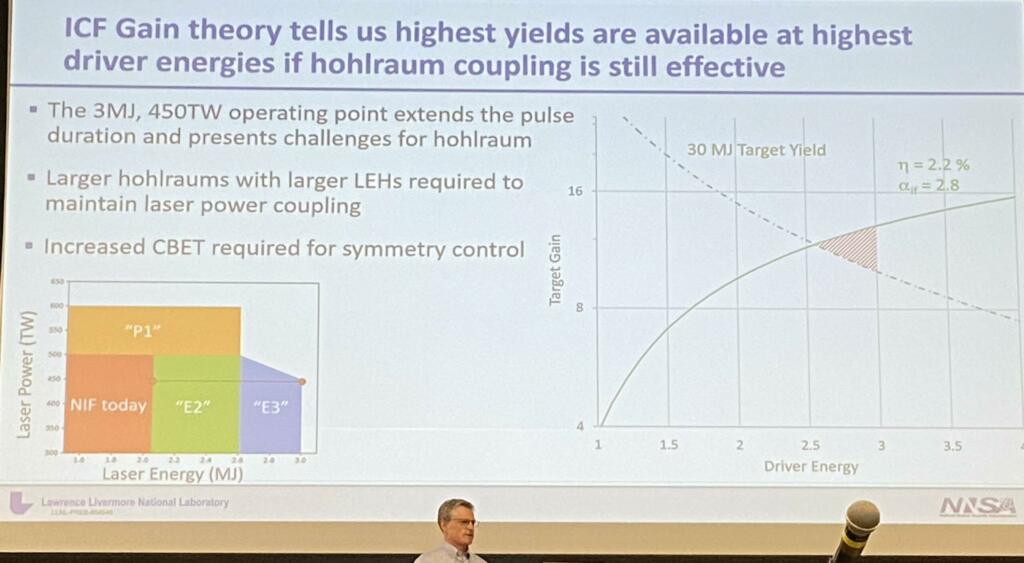

Brian Wang is a Futurist Thought Leader and a popular Science blogger with 1 million readers per month. His blog Nextbigfuture.com is ranked #1 Science News Blog. It covers many disruptive technology and trends including Space, Robotics, Artificial Intelligence, Medicine, Anti-aging Biotechnology, and Nanotechnology.
Known for identifying cutting edge technologies, he is currently a Co-Founder of a startup and fundraiser for high potential early-stage companies. He is the Head of Research for Allocations for deep technology investments and an Angel Investor at Space Angels.
A frequent speaker at corporations, he has been a TEDx speaker, a Singularity University speaker and guest at numerous interviews for radio and podcasts. He is open to public speaking and advising engagements.


laser fusion is a dead-end given low cycle rates of insanely precise high power laser systems and ultra-precise hohlraum shaping and positioning needed – though maybe it could work if it was all scaled up by orders of magnitude to relax the precision required.
Overall FRC like Helion present a far cheaper and shorter path towards economic fusion. And older approaches like Tokmaks and ICF seem doomed to economic irrelevance.
From the NYTimes article, not everybody is using hohlraums, and laser cycle rates are up to several times per second.
Helion does seem likely to dominate if it works. I’m optimistic, but laser fusion has the unique advantage of having already achieved scientific Q>1.
Nations burning coal and natural gas must have exports carbon taxed.
https://youtu.be/M8iEEO2UIbA
Nations burning coal and natural gas have a clear advantage. Invest in Australia, Bulgaria, Serbia, Kazakhstan, Czech Republic, New Caledonia, USA, and Poland.